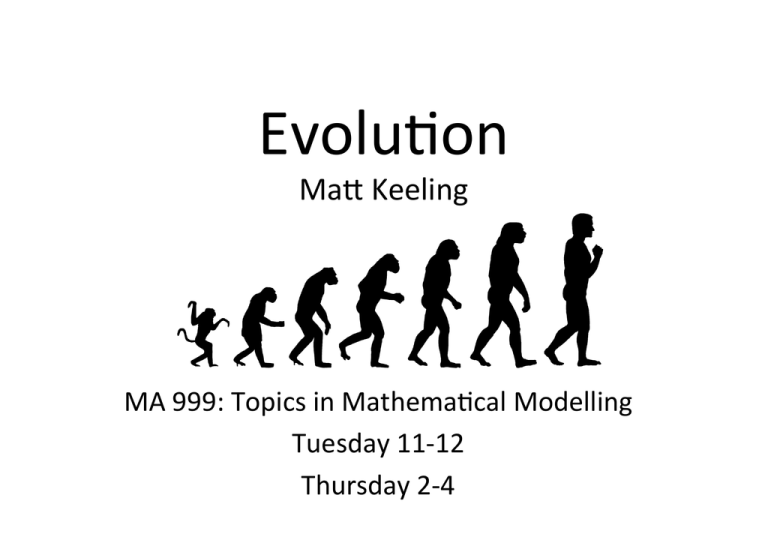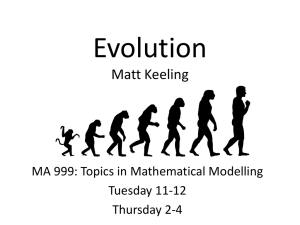Document 13330147
advertisement

Evolu&on Ma+ Keeling MA 999: Topics in Mathema&cal Modelling Tuesday 11-­‐12 Thursday 2-­‐4 Evolu&on Lecture 1 Tuesday 6th 11-­‐12 Introduc)on. Evidence for evolu&on. Fitness. Compe&&on. Lecture 2 Thursday 8th 2-­‐3 Games & Genes. Lecture 3 Thursday 8th 3-­‐4 Computer-­‐based prac)cals – example programs and ques&ons. Lecture 4 Tuesday 13th 11-­‐12 Sex and Specia)on. Sexual selec&on. Males as parasites. Why sexual reproduc&on? How do new species arise. Lecture 5 Thursday 15th 2-­‐3 Disease evolu)on. Why aren’t we all wiped out by killer infec&ons? Lecture 6 Thursday 15th 3-­‐4 Computer-­‐based prac)cals – example programs and ques&ons. Games and Genes Genes. Obvious, we all known now that our behaviour/fitness is largely governed by our genes. Here we’ll consider traits which are governed by two alleles at a single locus. Games. Two-­‐player games provide a robust and easy mathema&cal framework to deal with the interac&on (and compe&&on) between individuals ‘playing’ different strategies. We’ll consider the mathema&cs and some classic examples. Genes The classic example is eye colour. Blue and Brown eyes are (mostly) governed by a single locus. The colour of someone’s eyes is determined by the 2 genes they inherit from their parents. In this example the Brown allele(Br) is dominant, and the Blue allele(bl) is recessive. Father Br Br Mother bl bl Children Br bl This example is easy – all children are Br bl and have brown eyes. This shows the difference between genotype and phenotype. (Please don’t ask about green eyes !! ) Genes Other combina&ons. Father Br bl Children Br bl Children Br bl Mother bl bl Children bl bl Children bl bl In this combina&on of Brown-­‐eyed Father and Blue-­‐eyed Mother there is a 50:50 ra&o in the children. Genes Other combina&ons. Father Br Br Children Br Br Children Br Br Mother Br bl Children Br bl This clearly illustrates the dominance of the Brown eye allele. Children Br bl Genes Finally the slightly odd one: Father Br bl Children Br Br Children Br bl Mother Br bl Children Br bl Children bl bl So due to the fact that a Brown-­‐eyed parent can be “hiding” a blue gene, it is possible for two Brown-­‐eyed parents to have a Blue-­‐eyed child. No&ce that there are always four ways of pueng together the parents’ genes – even if ofen these lead to the same combina&on. Genes In general, we can use these caricatures to define popula&on-­‐level distribu&ons. If we assume that ma&ng is random… – that is blue-­‐eyed individuals don’t preferen&ally partner other blue-­‐eyed people …then the Hardy-­‐Weinberg Ra)o says that If Xi is the propor&on of allele Ai in the popula&on then the propor&on of the popula&on who are type Ai Aj is simply Xi Xj. So if the propor&on of blue-­‐eye alleles in the popula&on is b (and say b=0.2) then: Br Br = (1-­‐b)2 = 0.64 Br bl = bl Br = b (1-­‐b) = 0.16 bl bl = b2 = 0.04 So only 4% of the popula&on would have blue eyes. Genes Usually we don’t think of eye-­‐colour as giving a substan&al evolu&onary advantage (although clearly there is some dependence on la&tude). Let’s consider three different examples and their mathema&cal models: Haemophilia. Recessive gene&c disorder – individuals of type hh have problems producing blood cloeng agents. (Note this gene is on the X chromosome, so affects males differently to females – but we’ll ignore this complica&on). Fatal Muta)on. What if there was a muta&on that was dominant and gave a lower fitness? Sickle-­‐cell disease. Again this is recessive; type aa suffer from extreme anaemia, type Aa and AA do not – but type Aa has some level of protec&on against malaria. Genes Consider alleles of type A and a. The dynamics are described by: da = [ Fitness of a-type offspring] − a × [ Fitness of average offspring] dt = #$Waa a 2 + 12 WaA a(1− a) + 12 WAa (1− a)a%& − a × #$Waa a 2 + 2WaA a(1− a) + WAA (1− a)2 %& = Waa a 2 (1− a) + WaA a(1− a)(1− 2a) − WAA a(1− a)2 = a(1− a) [Waa a + WaA (1− 2a) − WAA (1− a)] Where the W terms are the reproduc&ve fitnesses of each allele combina&on. This allows us to experiment with different real-­‐world examples. Two-­‐Player Games A two-­‐player game can be defined by a pay-­‐off matrix; this gives the payoff an individual playing strategy s gains when playing against strategy s’. Pay-­‐off to strategy s1 s2 s1 A B s2 C D We then want to suppose that each strategy reproduces based on its pay-­‐off matrix: ds1 = s1s1 A + s1s2 B dt ds2 = s2 s1C + s2 s2 D dt ds d ! s1 $ = # & = s(1− s) [ sA + (1− s)B − sC − (1− s)D ] dt dt " s1 + s2 % Two-­‐Player Games More generally, we would like to set Pi as the propor&on of individuals playing strategy i, and set W to be the pay-­‐off matrix. In this case, the generalised model is: dPi T dt = [ WP ]i Pi − "# P WP$% Pi If we then define the average fitness (per individual) within this popula&ons to be: T ω = P WP then we find that if W is symmetric, then fitness always increases over &me. Two-­‐Player Games: mixed strategies Suppose now instead of playing pure strategies s1 and s2, the two players decide to randomly play a mixed strategy (ie playing s1 a propor&on p of the &me). Seeng P=(p 1-­‐p)T and Q=(q 1-­‐q)T, we have: Pay-­‐off to strategy p q p PTWP PTWQ q QTWP PTWQ The most famous example of this type of 2-­‐player game is the hawk-­‐dove model: D H " % D 1 0 ' W = $$ ' H A (> 1) −B (< 0) # & Where doves are peaceful and share a resource, whereas hawks are compe&&ve and fight for a resource. Two-­‐Player Games: ESS An Evolu&onary Stable Strategy (or ESS) is a strategy (pure or mixed) that cannot be invaded. Mathema&cally this means that P is an ESS if: QT WP ≤ P T WP ∀Q That is, there is no other strategy (Q) that can invade a popula&on of P’s. Note: 1) An ESS does not op&mise fitness, it is simply more fit than others in its own environment. 2) Mul&ple ESS can easily exist. 3) Ofen we can consider a local ESS, which is sufficient if muta&on is short-­‐range. An ESS is strongly or con)nuously stable if it is also an evolu&onary a+ractor: P T WQ ≥ QT WQ ∀Q That is, it can out-­‐compete all other strategies. Two-­‐Player Games: Bishop-­‐Canning theorem If P is an ESS composed of pure strategies s1, s2, … sn; then in an environment of all P the payoff to all pure strategies is equal to that of the ESS. siT WP = P T WP ∀i The proof of this comes from realising that P is a linear combina&on of the pure strategies; so if the equality does not hold, then some strategy will perform be+er than P, so it cannot be an ESS. Invasion Plots These provide an ideal means of rapidly visualising the evolu&onary behaviour. Invading Strategy Resident strategy wins, invader has nega&ve growth rate. Invading strategy successful, invader has posi&ve growth rate. Resident Strategy This form of invasion plot (or Pairwise invasibility plot) is associated with a strongly stable ESS. At the cross-­‐over point, nothing else can invade (so its an ESS); also the strategy is able to invade any other strategy.




